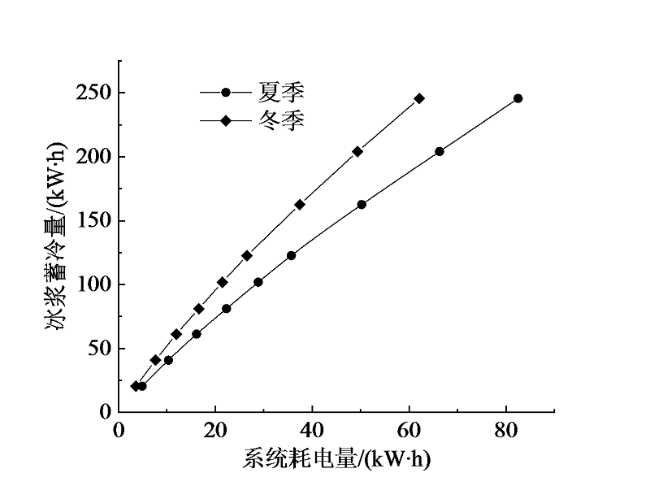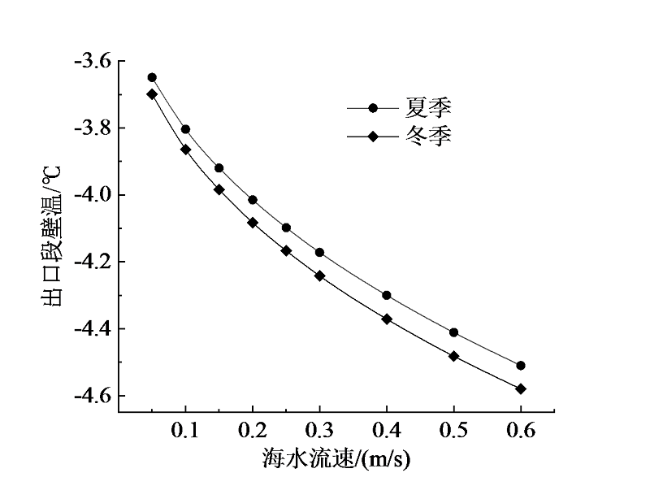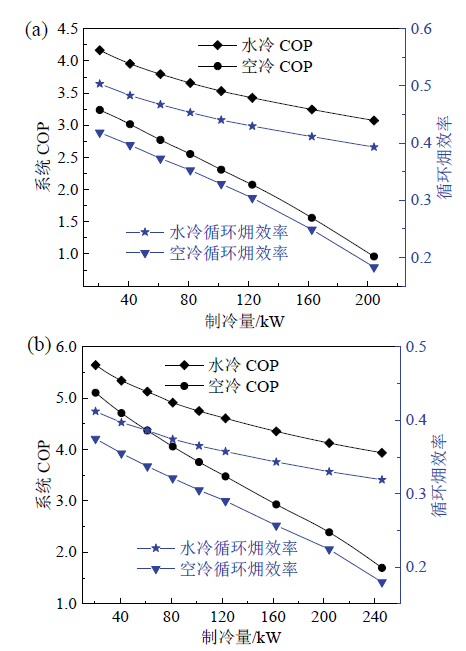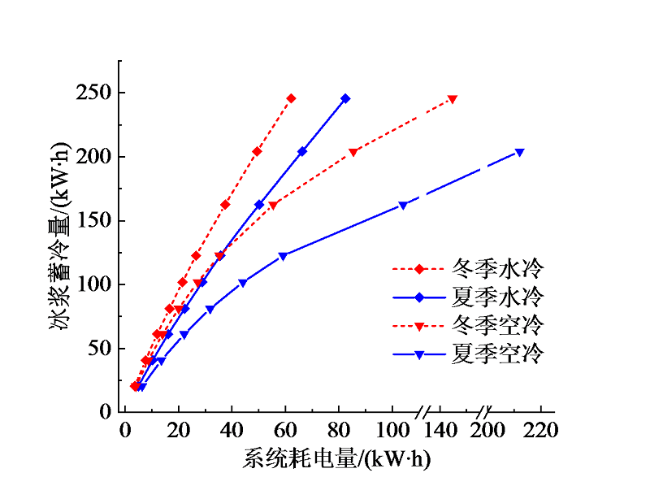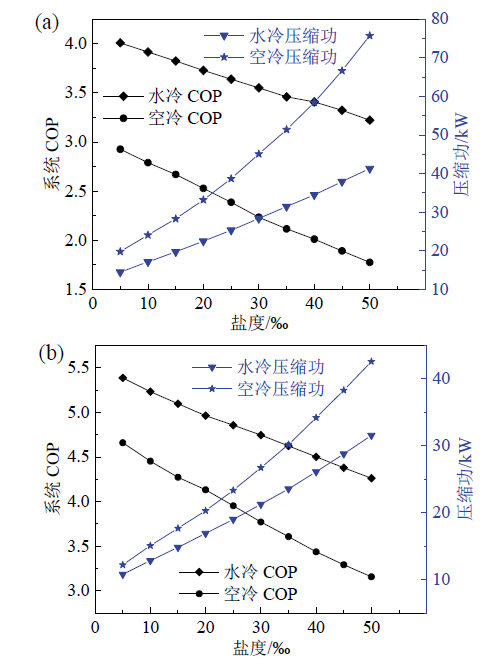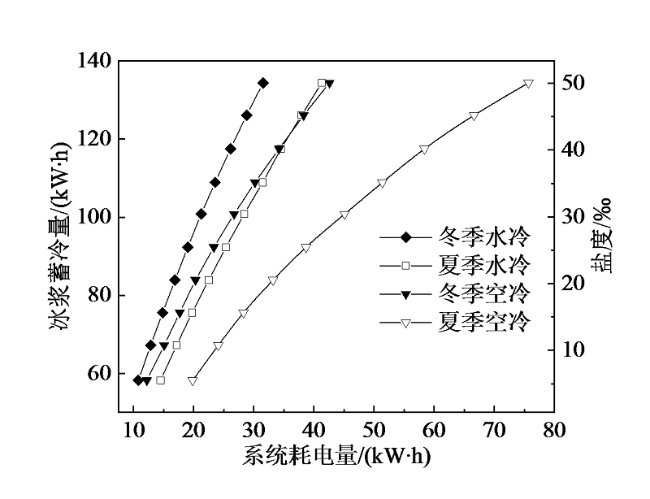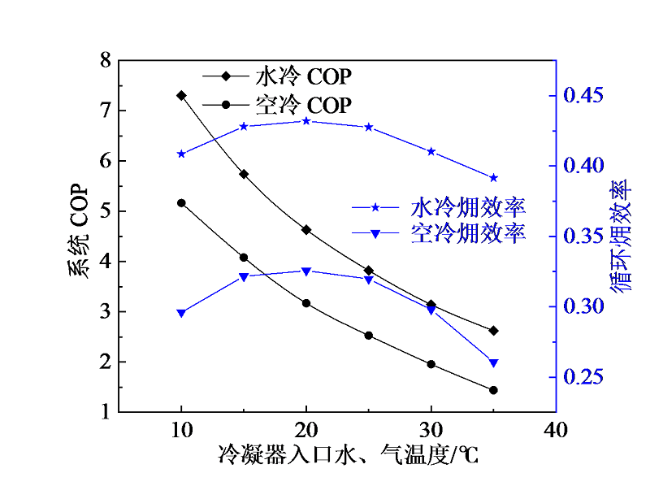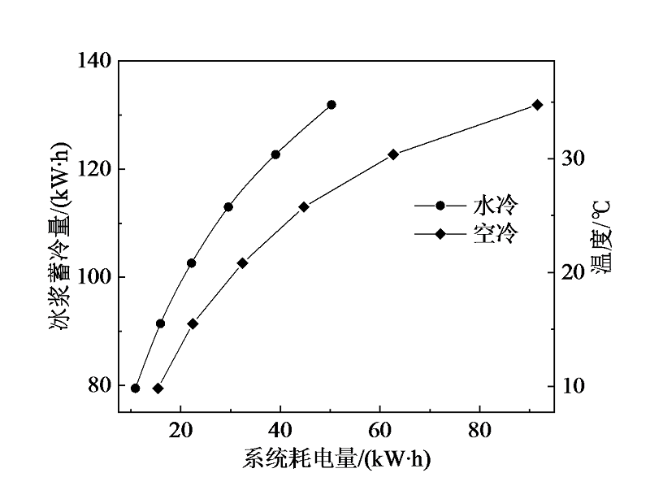0 引言
1 计算模型与数据处理方法
1.1 计算模型
Fig. 1 Sketch of device for making ice slurry from seawater图1 海水制冰浆装置简图 |
Table 1 Plate parameters of horizontal corrugated form plate heat exchanger表1 水平波纹形式板式换热器板片参数 |
| 参数/单位 | 数值 |
|---|---|
| 板间距/mm | 4.8 |
| 流道宽度/mm | 430 |
| 板片厚度/mm | 1.2 |
| 换热面积/m2 | 0.52 |
| 板材导热系数/[W/(m2∙℃)] | 14.4 |
Table 2 Seawater and air data of the East China Sea in summer and winter表2 东海夏季和冬季海水、空气数据 |
| 参数/单位 | 数值 |
|---|---|
| 平均水温/℃ | 27.6(夏) |
| 19.3(冬) | |
| 平均气温/℃ | 28.6(夏) |
| 15.6(冬) | |
| 盐度/‰ | 31 ~ 32 |
| 冰点/℃ | -1.83 |
| 出水温度/℃ | -3.33 |
1.2 系统主要性能计算方法
2 计算结果分析
2.1 制冷循环效率分析
Fig. 2 COP and exergy efficiency (a), and ice production (b) of the system under different seawater flow rate in summer and winter图2 夏季和冬季在不同海水流速下的系统COP值、㶲效率(a)和制冰量(b) |
Fig. 3 The relationship curve between cool-storage capacity and power consumption in summer and winter图3 夏、冬季蓄冷量与耗电量关系曲线 |
Fig. 4 Temperature variation law of outlet section wall with seawater flow rate图4 出口段壁温随海水流速变化规律 |
2.2 与空气冷却器对比
Table 3 Air cooler horizontal low-fin heat exchanger tube parameters表3 空气冷却器水平式低翅片换热管参数 |
| 参数/单位 | 数值 |
|---|---|
| 管根数/根 | 34 |
| 管排数/排 | 4 |
| 管内径/cm | 2 |
| 管外径/cm | 2.5 |
| 管长/m | 4.5 |
| 管材导热系数/[W/(m2∙℃)] | 30 |
Fig. 5 The variation law of circulating COP value and exergy efficiency of the system with different load using water cooling and air cooling in summer (a) and winter (b)图5 夏季(a)和冬季(b)水冷、空冷的系统COP、㶲效率随负荷变化规律 |
Fig. 6 The relationship curve between the cool-storage capacity and power consumption using water cooling and air cooling in summer and winter图6 夏冬季水冷、空冷蓄冷量与耗电量关系曲线 |
Table 4 Breakdown of initial investment costs for both units表4 两种机组初投资成本明细 |
| 机组 | 设备费/万元 | 安装费/万元 | 总价/万元 |
|---|---|---|---|
| 空冷机组 | 16 | 1.6 | 17.6 |
| 水冷机组 | 18 | 1.8 | 19.8 |
Table 5 Operating costs of both units with different cooling capacities表5 不同制冷量条件下两种机组的运营成本 |
| 机组 | 运营成本/(万元/a) | ||||
|---|---|---|---|---|---|
| 40 kW | 80 kW | 120 kW | 160 kW | 200 kW | |
| 空冷机组 | 7.87 | 18.76 | 35.10 | 60.64 | 110.00 |
| 水冷机组 | 6.52 | 14.10 | 22.53 | 31.70 | 41.77 |
Table 6 Cool-storage capacity per unit investment in the first year of both units with different cooling capacities表6 不同制冷量条件下两种机组的首年单位投资蓄冷量 |
| 机组 | 单位投资蓄冷量/(kW∙h/元) | ||||
|---|---|---|---|---|---|
| 40 kW | 80 kW | 120 kW | 160 kW | 200 kW | |
| 空冷机组 | 1.38 | 1.93 | 2.00 | 1.79 | 1.37 |
| 水冷机组 | 1.33 | 2.07 | 2.48 | 2.72 | 2.85 |
Fig. 7 The variation law of circulating COP value and compression work of the system with different seawater salinity using water cooling and air cooling in summer (a) and winter (b)图7 夏季(a)和冬季(b)水冷、空冷的系统COP值、压缩功随海水盐度变化规律 |
Fig. 8 The relationship curve between the cool-storage capacity and power consumption using water cooling and air cooling under variable salinity conditions in summer and winter图8 夏冬季变盐度条件下水冷、空冷蓄冷量与耗电量关系曲线 |
Fig. 9 The variation law of circulating COP value and exergy efficiency of the system with different inlet temperature of condenser under water cooling and air cooling conditions图9 水冷、空冷的系统COP值、㶲效率随冷凝器入口温度变化规律 |
Fig. 10 The relationship curve between the cool-storage capacity and power consumption using water cooling and air cooling under variable inlet temperature conditions of the condenser图10 变冷凝器入口温度条件下水冷、空冷蓄冷量与耗电量关系曲线 |






